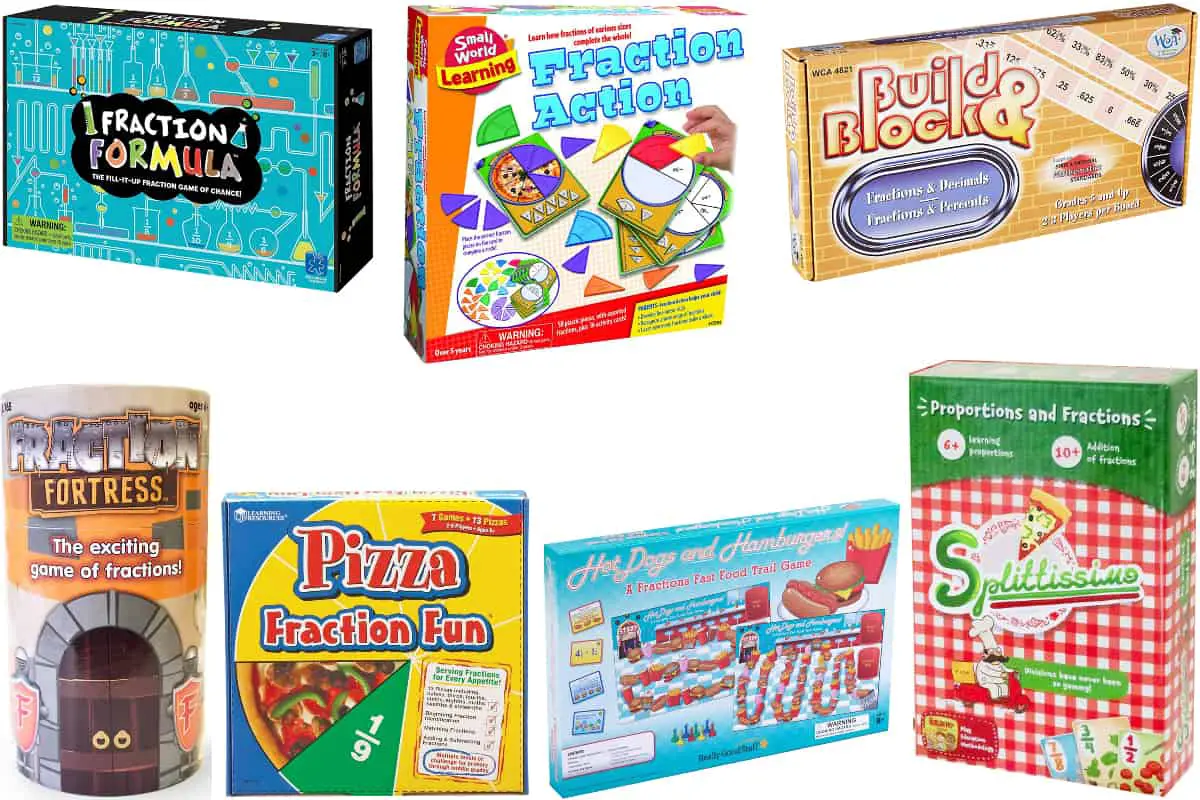This post contains affiliate links.
Here is a list of engaging fraction board games that kids will love. Say the word “fractions” and most children groan. Their experience with this fundamental math concept is often unpleasant and makes little sense to them – until they “get it” hopefully through a game.
So what fraction board games are available? There are 16 fraction board games – the age range between 3 to approximately 12. These games work great in small group classroom settings, but can also be used at home as well. I highly recommend Fraction Fortress, Fraction Formula and Montessori Learn Fraction.
Fractions Board Games Comparison Table
The table below makes it easier for you to compare them.
| Game | Age | Players | Price | For | Topic* | Rating |
|---|---|---|---|---|---|---|
| Pizza Fraction Fun | 6+ | 2‑6 | $17 | School | I, M, A, S | ★★★★☆ |
| Fraction Action | 5‑8 | 2‑4 | $22 | School, Home | I | ★★★★★ |
| Montessori Learn Fraction | 4‑6 | 2 | $30 | Home | I, R | ★★★★☆ |
| Pie in the Sky | 7+ | 2‑4 | $40 | School, Home | I | ★★★★☆ |
| Fraction City | 10+ | 2-4 | $30 | School | B | ★★★☆☆ |
| Fraction Fortress | 6‑10 | 2‑4 | $26 | School, Home | P | ★★★★★ |
| Fraction Formula | 8+ | 2‑4 | $19 | School, Home | I, A | ★★★★☆ |
| Hotdogs and Hamburgers | 8+ | 2‑4 | $30 | School, Home | B | ★★★☆☆ |
| Climb the Cliff | 9+ | 2‑4 | $50 | Home | B | ★★★☆☆ |
| Fractions Learning Center | 6‑8 | 2‑4 | $25 | School | I, R | ★★★☆☆ |
| All About Fractions | 8‑11 | 2‑4 | $25 | School | E, A, S | ★★★☆☆ |
| Adding and Subtracting Fractions | 8‑11 | 2‑4 | $25 | School | A, S | ★★★☆☆ |
| Multiplying and Dividing Fractions | 8‑11 | 2‑4 | $25 | School | MD | ★★★☆☆ |
| Splitissimo | 8-13 | 2‑6 | $15 | School, Home | I, M, A, S | ★★★☆☆ |
| Build & Block | 6+ | 2‑3 | $20 | School | C | ★★★☆☆ |
| Fractions and Decimals | 3‑10 | 2‑3 | $30 | School | C, R, B | ★★★☆☆ |
*Topics (concepts taught):
B: Basic operations (addition, subtraction, multiplication and division) of fractions
I: Identifying Fractions
M: Matching fraction equivalents
A: Adding fractions
P: Proportion
S: Subtracting fractions
C: Converting fractions to decimals or to percentages
R: Representing fractions
E: Equivalent fractions
MD: Multiplying and dividing fractions
Fractions Board Games for Kindergarten
Pizza Fraction Fun (Learning Resources)
★★★★☆
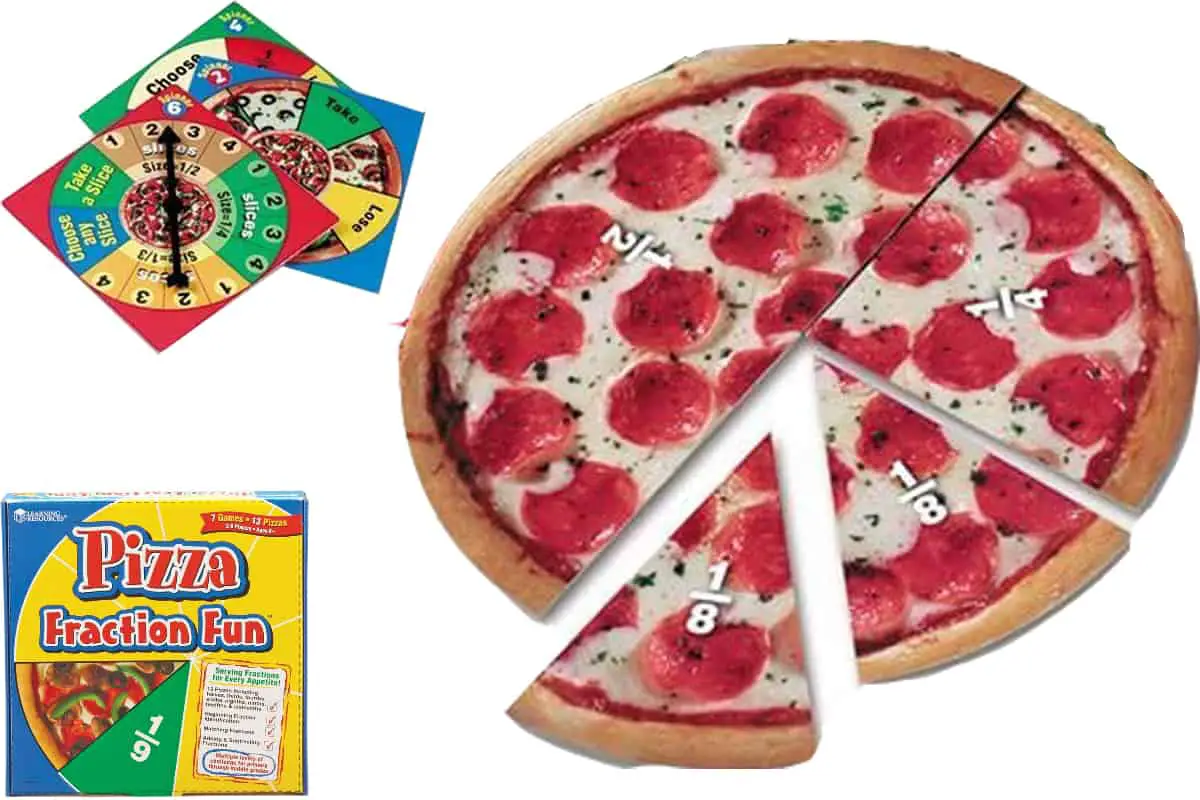
2-6 players | Age 6+ | Grade K2–4 | For Schools
The Pizza Fraction Fun board game provides a real-life representation of fractions to which students can relate. Vivid pizza slices create a mouth-watering game experience that young children will love.
board game provides a real-life representation of fractions to which students can relate. Vivid pizza slices create a mouth-watering game experience that young children will love.
Seven rules can be used with the game pieces, each for a different year group or ability level. they teach students to: identify fractions, match fraction equivalents and perform fraction addition and subtraction.
I recommend this game for schools rather than for families because it has rather low replayability.
Fraction Action (Small World Toys)
★★★★★

2-4 players | Age 5-8 | Grade K2–2
Fraction Action is a great game for teaching young children how to identify common fractions. The fraction pieces are colorful and easy to fit together to make a whole. There are 58 fraction pieces and 16 activity cards so students can put various combinations of fractions together. It’s a very simple game that is perfect for young children who are learning the fundamentals of fractions.
is a great game for teaching young children how to identify common fractions. The fraction pieces are colorful and easy to fit together to make a whole. There are 58 fraction pieces and 16 activity cards so students can put various combinations of fractions together. It’s a very simple game that is perfect for young children who are learning the fundamentals of fractions.
Montessori Learn Fraction Math Toy (Canadian Moms Care)
★★★★☆
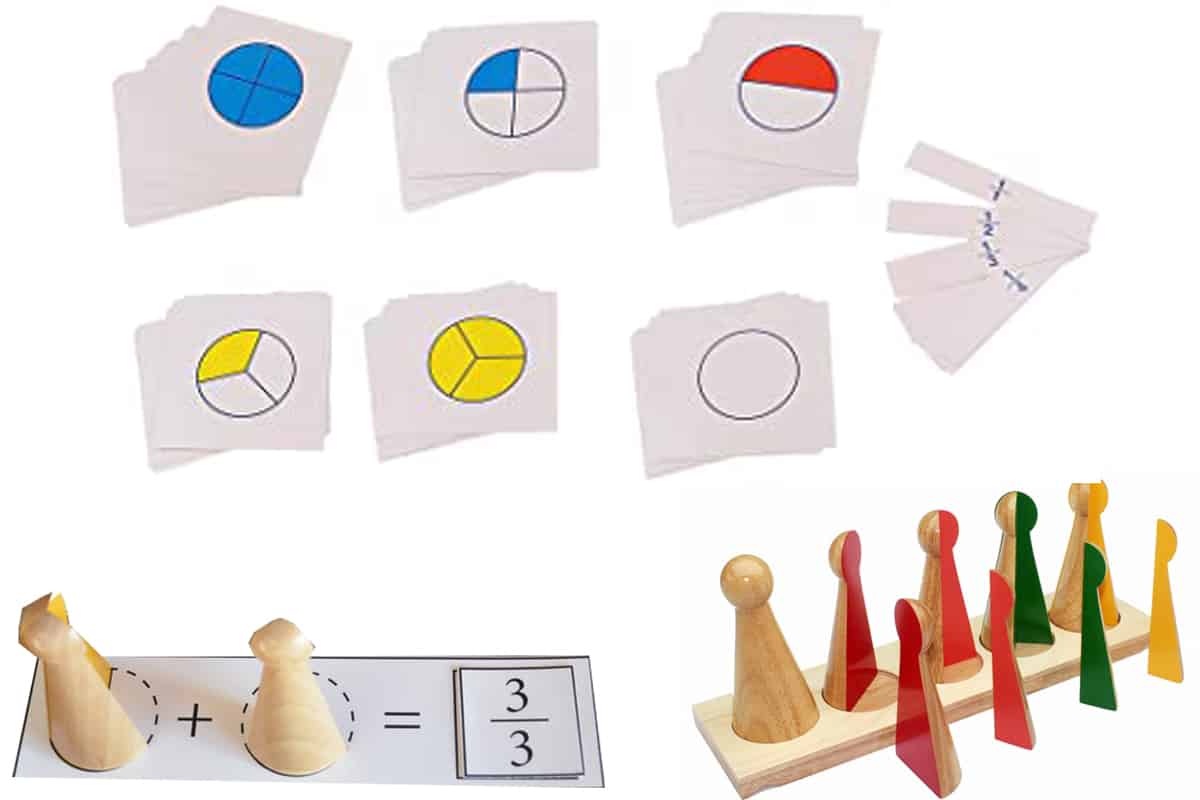
2 Players | Age 4-6 | Grade K2–2
The beauty of the Montessori Learn Fraction Math Toy is the 3D representation of four fundamental fractions (1/1, ½, 1/3, ¼). It’s a great game for tactile and visual learners who are being introduced to fractions for the first time. Children can see a visual representation of the fractions on the picture cards and can then replicate the fractions using the 3D wooden models. The publisher also provides clear instructions on how to use the game in multiple ways with an increasing level of difficulty depending on the child’s age and learning ability.
is the 3D representation of four fundamental fractions (1/1, ½, 1/3, ¼). It’s a great game for tactile and visual learners who are being introduced to fractions for the first time. Children can see a visual representation of the fractions on the picture cards and can then replicate the fractions using the 3D wooden models. The publisher also provides clear instructions on how to use the game in multiple ways with an increasing level of difficulty depending on the child’s age and learning ability.
FractionsBoard Games for Primary/Elementary School
Pie in the Sky (Learning Resources)
★★★★☆
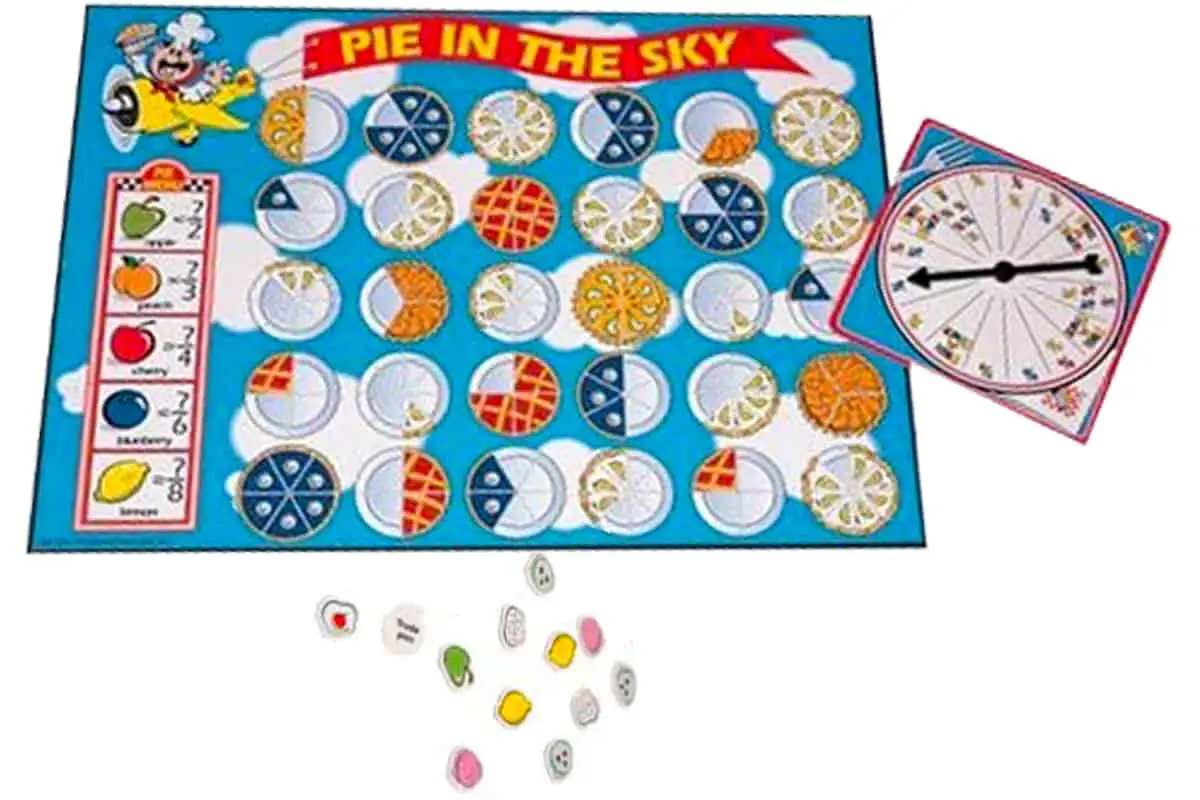
2-4 players | Age 7+ | Grade 1-2
Pie in the Sky is a great game for reinforcing how to represent fractions. Students spin a spinner and are required to place a marker on the fraction that the spinner lands on. The first player to get three markers in a row wins. It’s a simple game that can be used as a cumulative activity for an introductory lesson on fractions. Parents can also use it as a quick reinforcement activity before their children complete a fraction assignment.
is a great game for reinforcing how to represent fractions. Students spin a spinner and are required to place a marker on the fraction that the spinner lands on. The first player to get three markers in a row wins. It’s a simple game that can be used as a cumulative activity for an introductory lesson on fractions. Parents can also use it as a quick reinforcement activity before their children complete a fraction assignment.
Fraction City (Learning Advantage)
★★★☆☆
2-4 players | Age 10+ | Grade 5-8
Fraction City is a great game for learning how to use the basic operations with fractions to achieve a value of one. The aim is to collect ten fraction tiles. Therefore, students have to strategize to determine the best route to get the fractions they need. Although this helps students think carefully about how to combine fractions, it prolongs the game since each player will move very slowly to ensure that he or she is choosing the best combination.
is a great game for learning how to use the basic operations with fractions to achieve a value of one. The aim is to collect ten fraction tiles. Therefore, students have to strategize to determine the best route to get the fractions they need. Although this helps students think carefully about how to combine fractions, it prolongs the game since each player will move very slowly to ensure that he or she is choosing the best combination.
Prolonged play results in boredom. Additionally, there is no clear sense of direction on the board.
Fraction Fortress (Junior Learning)
★★★★★
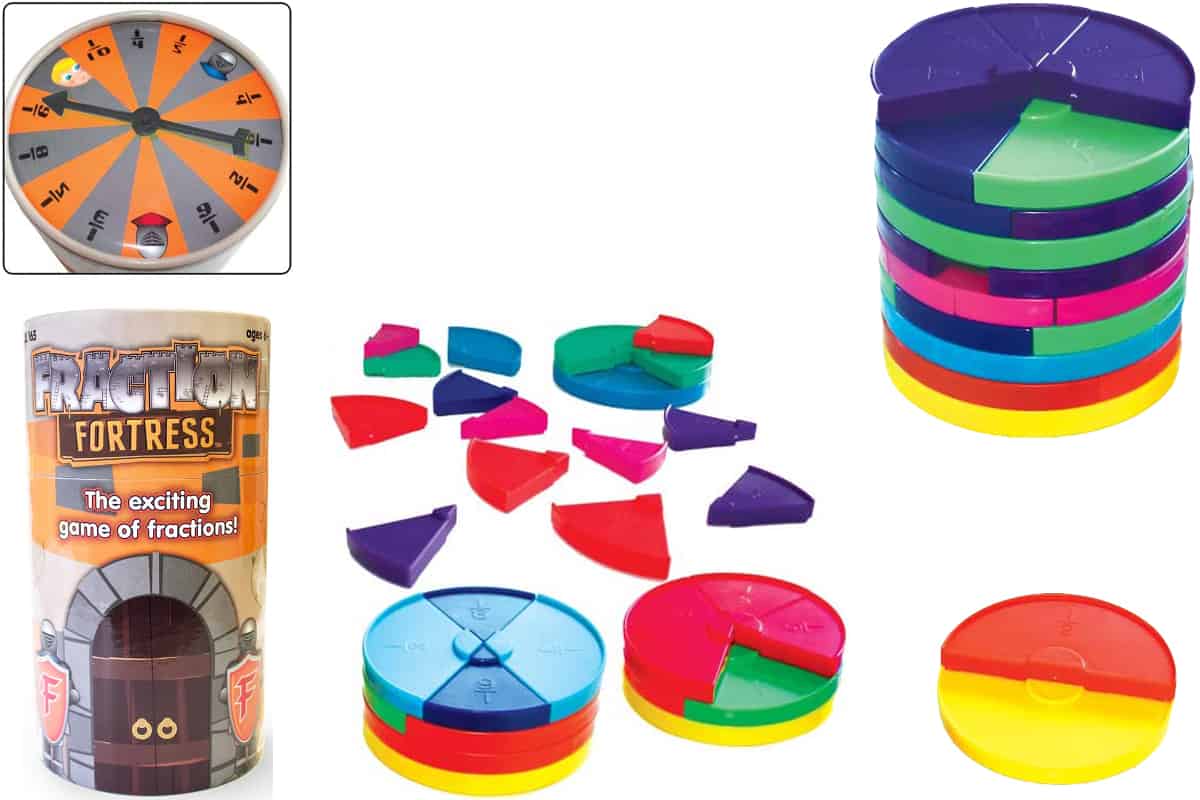
2-4 players | Age 6-10 | Grade 1-4
Fraction Fortr ess is a multi-sensory game that teaches students multiple fraction concepts including identifying proportions, adding and subtracting fractions and establishing fraction patterns. Students are highly engaged in spinning the wheel and stacking their game pieces so that they can create the highest fortress. The game pieces can also be used as manipulatives to teach younger children common fractions.
ess is a multi-sensory game that teaches students multiple fraction concepts including identifying proportions, adding and subtracting fractions and establishing fraction patterns. Students are highly engaged in spinning the wheel and stacking their game pieces so that they can create the highest fortress. The game pieces can also be used as manipulatives to teach younger children common fractions.
Fraction Formula (Educational Insights)
★★★★☆

2-4 players | Age 8+ | Grade 4-7
Fraction Formula is great for showing cross-curricula linkages between math and science. Each player gets a large test tube. The plastic fraction pieces are placed in the center of the game. Each player draws a fraction card and puts the corresponding fraction piece into the test tube. The first player to fill the test tube without it “overflowing” is the winner. So, the strategy is correctly determining if adding another fraction piece to the best tube is worth the risk.
is great for showing cross-curricula linkages between math and science. Each player gets a large test tube. The plastic fraction pieces are placed in the center of the game. Each player draws a fraction card and puts the corresponding fraction piece into the test tube. The first player to fill the test tube without it “overflowing” is the winner. So, the strategy is correctly determining if adding another fraction piece to the best tube is worth the risk.
Students identify physical representations of common fractions. Those in grades 4 to 7 enjoy this game because it doesn’t make learning fraction recognition a chore. Nevertheless, the game essentially only teaches the basics of identifying fractions and is, therefore, best suited as an activity to introduce fractions.
Additionally, there would be a need for more fraction pieces. Those included in the game are limited to the most common fractions such as half, quarter and eighths. Pieces that represent sevenths, ninths, and elevenths would be a welcomed addition.
Hotdogs and Hamburgers: A Fractions Fast Food Trail Game (Really Good Stuff)
★★★☆☆
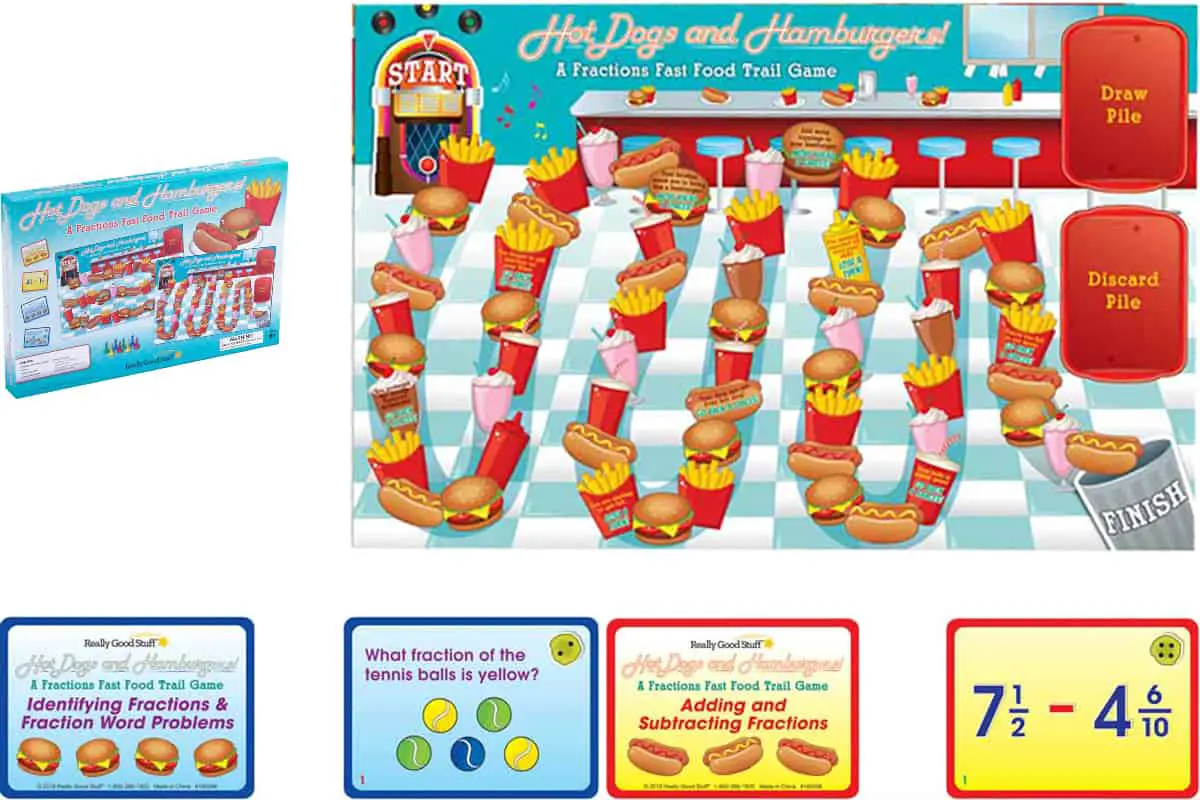
2-4 players | Age 8+ | Grade 3-6
One of the strengths of Hotdogs and Hamburgers is the options it provides. Players can choose from two decks of cards. One deck focuses on adding, subtracting and identifying fractions. The other deck focuses on fraction worded problems. Options are also offered in the game board design; each game board has two sides with one side having a longer trail than the other. It also has two game boards so that two sets of players can be involved simultaneously.
is the options it provides. Players can choose from two decks of cards. One deck focuses on adding, subtracting and identifying fractions. The other deck focuses on fraction worded problems. Options are also offered in the game board design; each game board has two sides with one side having a longer trail than the other. It also has two game boards so that two sets of players can be involved simultaneously.
Despite these options, this game is essentially just an amplified version of completing a worksheet of fraction questions. It can only be played once students have demonstrated complete mastery of the concepts tested in the game. Otherwise, they will become easily frustrated and the game will be tossed aside. It’s important for a game to help children have fun without making learning seem like a chore.
Additionally, the answer to each question isn’t on the individual question cards. Instead, all answers are on one answer sheet. This means that there has to be an additional player who checks the answers since alternating checking answers among the players means that they will see the answers for upcoming questions. This flaw is inconsequential if a parent is playing with children since the parent could be the person who checks the answers. However, it becomes an issue in a whole class setting where the teacher has to monitor multiple groups. An extra player would definitely be needed in this case, but this extra player won’t be fully engaged in the learning experience.
Climb the Cliff (Lakeshore Learning)
★★★☆☆
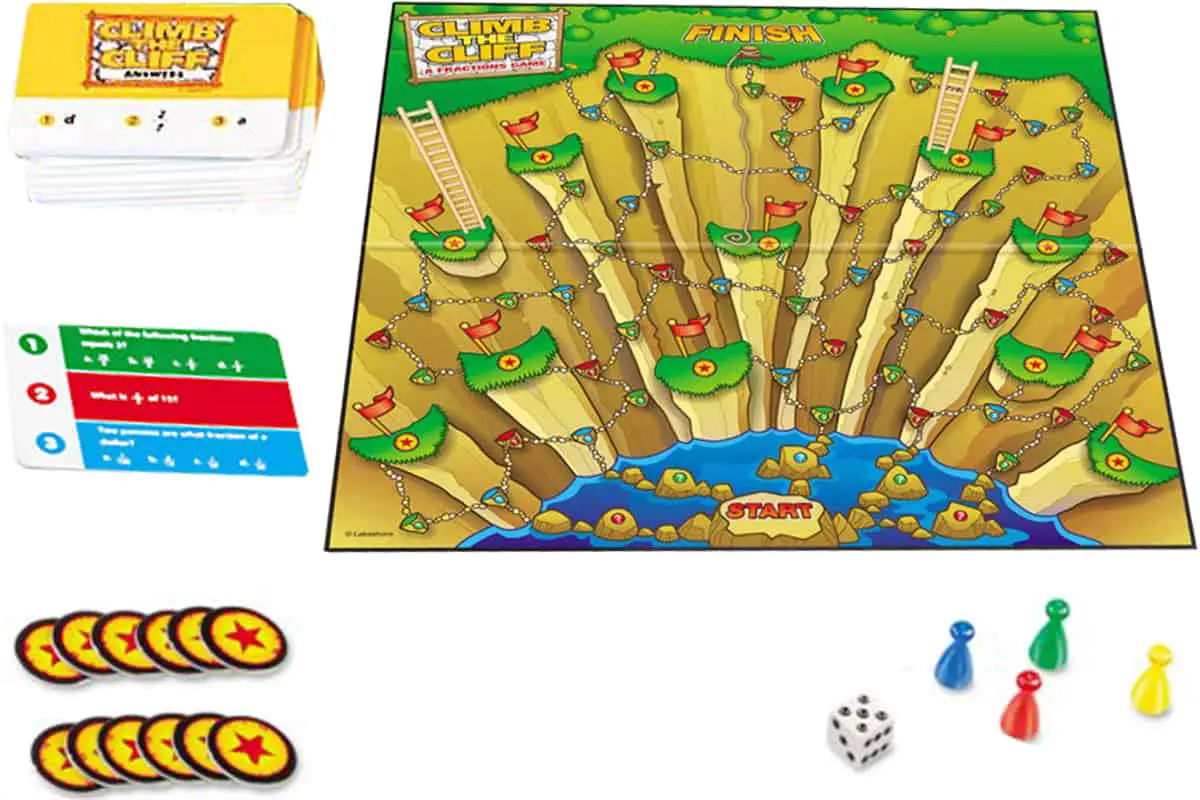
2-4 players | Age 9-10 | Grade 4-5
Climb the Cliff follows a question and answer format similar to Hotdogs and Hamburgers. However, each question card has three color-coded questions and the corresponding answer card. Players aim to get three questions in a row correct so that they can earn a star. Three stars allow them to move their game pieces up the game board and over the cliff.
follows a question and answer format similar to Hotdogs and Hamburgers. However, each question card has three color-coded questions and the corresponding answer card. Players aim to get three questions in a row correct so that they can earn a star. Three stars allow them to move their game pieces up the game board and over the cliff.
The game is a great concept in theory. However, the design of the board is confusing and the fact that players must answer three questions in each turn contributes to prolonged game play. There is also the challenge of the game experience feeling like completing a worksheet since it’s a basic question and answer format.
Fractions Learning Centers for Primary/Elementary School
Fractions Learning Center (New Path Learning)
★★★☆☆

2-4 players | Age 6-8 | Grade 1-2
This Fractions Learning Center from New Path Learning is fully equipped with self-checking question cards, a double-sided game board, game pieces, and Write-On/Wipe-Off visual learning guides. These resource materials are packaged in a Math Learning Centre pouch which for up to four students.
from New Path Learning is fully equipped with self-checking question cards, a double-sided game board, game pieces, and Write-On/Wipe-Off visual learning guides. These resource materials are packaged in a Math Learning Centre pouch which for up to four students.
Students can test their understanding of representing and identifying fractions using the self-checking question cards. They can also use the cards and game board to challenge up to three classmates. I consider it a valuable resource for revising.
All About Fractions Learning Center (New Path Learning)
★★★☆☆
2-4 players | Age 8-11 | Grade 3-5
The All About Fractions Learning Center is similar to the Fractions Learning Center kit because it’s fully equipped with self-checking question cards, a double sided game board, game pieces and Write-On/Wipe-Off visual learning guides. These resource materials are neatly packaged in a Math Learning Centre pouch which can serve up to four students.
is similar to the Fractions Learning Center kit because it’s fully equipped with self-checking question cards, a double sided game board, game pieces and Write-On/Wipe-Off visual learning guides. These resource materials are neatly packaged in a Math Learning Centre pouch which can serve up to four students.
Students can test their understanding of equivalent fractions and adding and subtracting fractions using the self-checking question cards. They can also use the cards and game board to challenge up to three classmates, which makes this learning center good for revising.
Adding and Subtracting Fractions Learning Center (New Path Learning)
★★★☆☆
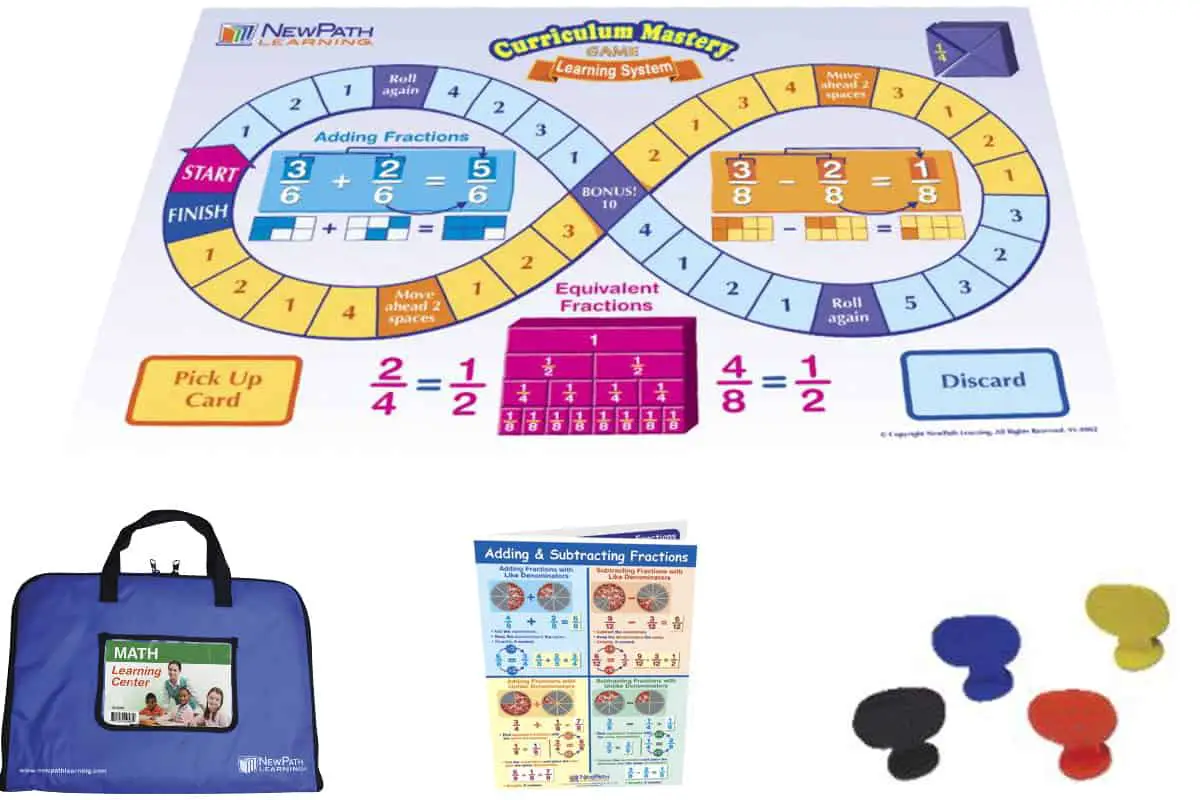
2-4 players | Age 8-11 | Grade 3-5
The Adding and Subtracting Fractions Learning Center perfectly complements the All About Fractions Learning Center to give students additional practice with adding and subtracting fractions. It has self-checking question cards, a double-sided game board, game pieces, and Write-On/Wipe-Off visual learning guides. These resources make it a good revision tool for up to four students.
perfectly complements the All About Fractions Learning Center to give students additional practice with adding and subtracting fractions. It has self-checking question cards, a double-sided game board, game pieces, and Write-On/Wipe-Off visual learning guides. These resources make it a good revision tool for up to four students.
Multiplying and Dividing Fractions Learning Center (New Path Learning)
★★★☆☆
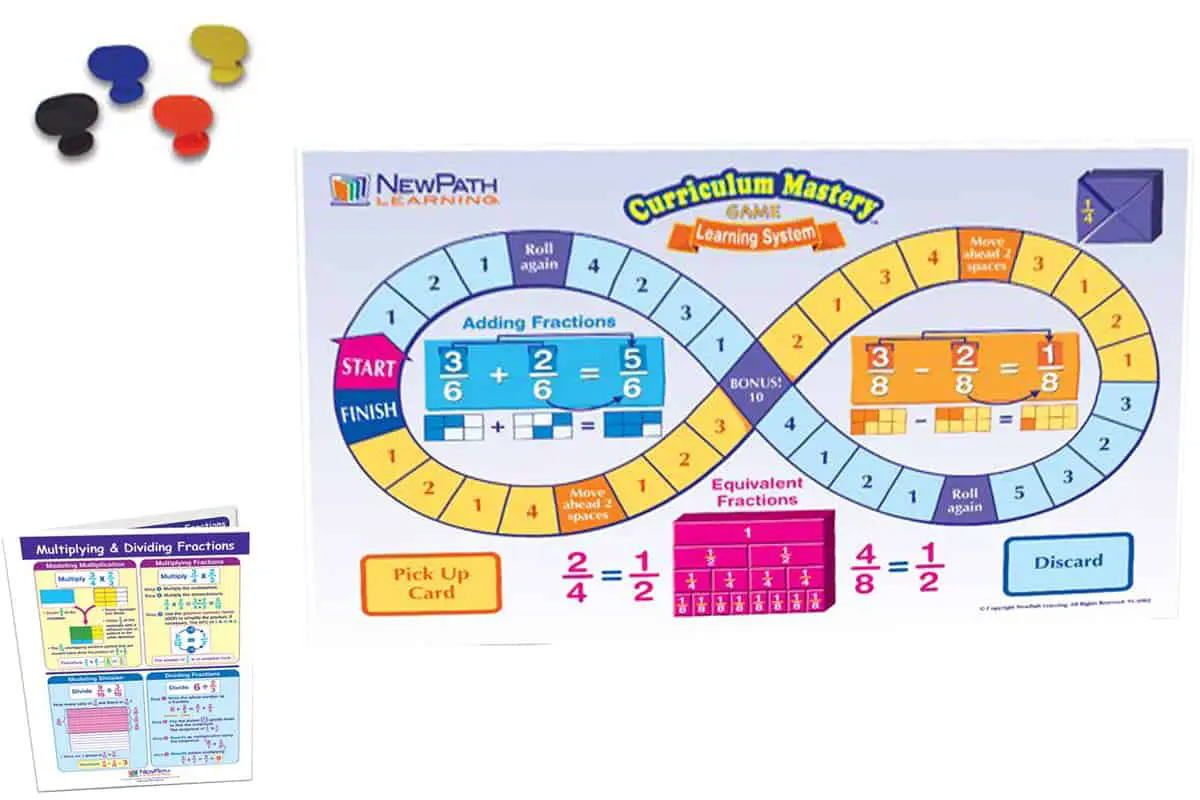
2-4 players | Age 8-11 | Grade 3-5
The Multiplying and Dividing Fractions Learning Center complements the All About Fractions Learning Center and the Adding and Subtracting Fractions Learning Center to give students practice with multiplying and dividing fractions. It has self-checking question cards, a double-sided game board, game pieces, and Write-On/Wipe-Off visual learning guides – packaged in a pouch for up to four students.
complements the All About Fractions Learning Center and the Adding and Subtracting Fractions Learning Center to give students practice with multiplying and dividing fractions. It has self-checking question cards, a double-sided game board, game pieces, and Write-On/Wipe-Off visual learning guides – packaged in a pouch for up to four students.
Fractions Board Games for Middle School and Up
Splitissimo (The Brainy Band)
★★★☆☆

2-6 players | Age 8-13 | Grade 4-7
Splitissimo brings fraction addition and subtraction into solving a real-life problem. The game is based on the fictional Italian pizzeria, Splitissimo, where customers only order slices of pizza. There are several ways to play the game, each with increasing difficulty. Regardless of the chosen version, students are asked to combine the pizza cards they’ve chosen to meet the customer’s order.
brings fraction addition and subtraction into solving a real-life problem. The game is based on the fictional Italian pizzeria, Splitissimo, where customers only order slices of pizza. There are several ways to play the game, each with increasing difficulty. Regardless of the chosen version, students are asked to combine the pizza cards they’ve chosen to meet the customer’s order.
This game is more a card game than a board game. The cards always need to be kept together because one missing card can throw off the entire game. There are a lot of “game pieces” to monitor.
Additionally, the instructions for each variation of the game are not easy for children from ages 6 to 8 to follow. Splitissimo is best suited for children between 8 and 13 years who need to understand more complex addition and subtraction of fractions.
Build and Block: Fraction & Decimals/ Fraction & Percents (Learning Advantage)
★★★☆☆
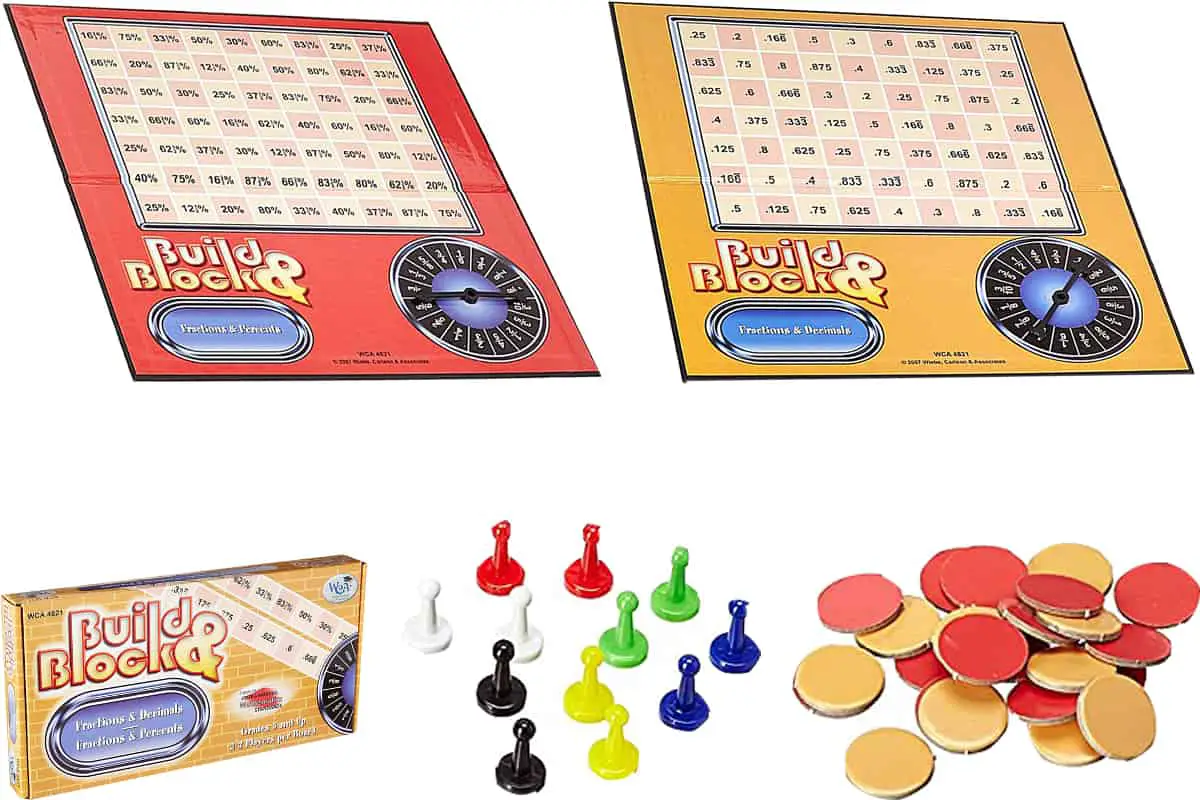
2-3 players | Age 6+ | Grade 6-7
Build and Block is a mental math game that forces students to quickly convert between decimals and fractions or decimals and percentages. Its concept is similar to Tic-Tac-Toe where the player’s aim is to be the first to cover four adjacent spots vertically, diagonally or horizontally. Another great feature is that there are two game boards which allow two sets of players to play simultaneously.
is a mental math game that forces students to quickly convert between decimals and fractions or decimals and percentages. Its concept is similar to Tic-Tac-Toe where the player’s aim is to be the first to cover four adjacent spots vertically, diagonally or horizontally. Another great feature is that there are two game boards which allow two sets of players to play simultaneously.
Fractions and Decimals Curriculum Mastery Game (New Path Learning)
★★★☆☆
2-3 players | Age 3-10 | Grade 3-6
The beauty of this New Path Learning fraction pack is that it covers an array of fraction-related topics. I’ve categorized it as a middle school game because of its decimal and percentage elements. Middle school students are introduced to more advanced fraction concepts such as converting fractions to decimals and percentages. Therefore, this game is useful for that purpose as well as for reinforcing fundamental fraction concepts that would have been taught in earlier grades.
is that it covers an array of fraction-related topics. I’ve categorized it as a middle school game because of its decimal and percentage elements. Middle school students are introduced to more advanced fraction concepts such as converting fractions to decimals and percentages. Therefore, this game is useful for that purpose as well as for reinforcing fundamental fraction concepts that would have been taught in earlier grades.
The game cards, pieces and board are neatly packaged in a game box. This makes it easy to store the game in a learning corner in a busy classroom. One drawback, however, is that the game doesn’t make the questions asked interesting and engaging. Students just flip over a card, answer the question and (if they answer correctly) move forward on the game board. Students tend to prefer games where they can engage multiple senses and have fun challenging their opponents. Additionally, students must have full concept mastery before they can attempt to answer the questions.
Other Fractions Games
Fraction fun isn’t limited to board games. Junior Learning created this attractive and highly creative Fraction Dominoes game. Children will have so much fun that it won’t even feel like a math lesson! It’s perfect for children in grades 1 to 3 who are just learning how to visualise fractions and can be taught the basics of playing dominoes. It would be great if this game could teach concepts such as equivalent fractions so that it could be used effectively with older children without them being bored.
game. Children will have so much fun that it won’t even feel like a math lesson! It’s perfect for children in grades 1 to 3 who are just learning how to visualise fractions and can be taught the basics of playing dominoes. It would be great if this game could teach concepts such as equivalent fractions so that it could be used effectively with older children without them being bored.
Another fun option is Legos. Yes, those Lego sets that you love so much can also be used to teach fractions. Deidre from Jdaniel4’s Mom blog created some awesome Lego Fraction Games
created some awesome Lego Fraction Games that parents can play with children who are in Grades 1 to 4.
that parents can play with children who are in Grades 1 to 4.
Edudingo.com is a participant in the Amazon Services LLC Associates Program, an affiliate advertising program designed to provide a means for sites to earn advertising fees by advertising and linking to Amazon.com. We also participate in other affiliate programs which compensate us for referring traffic.

